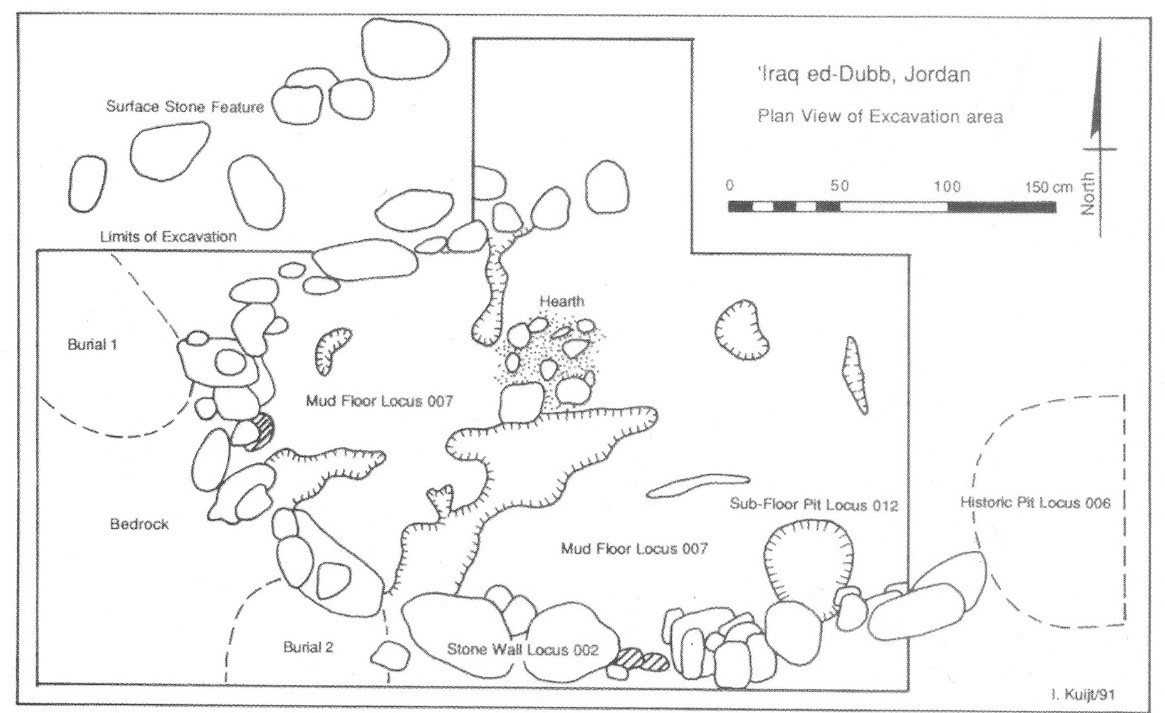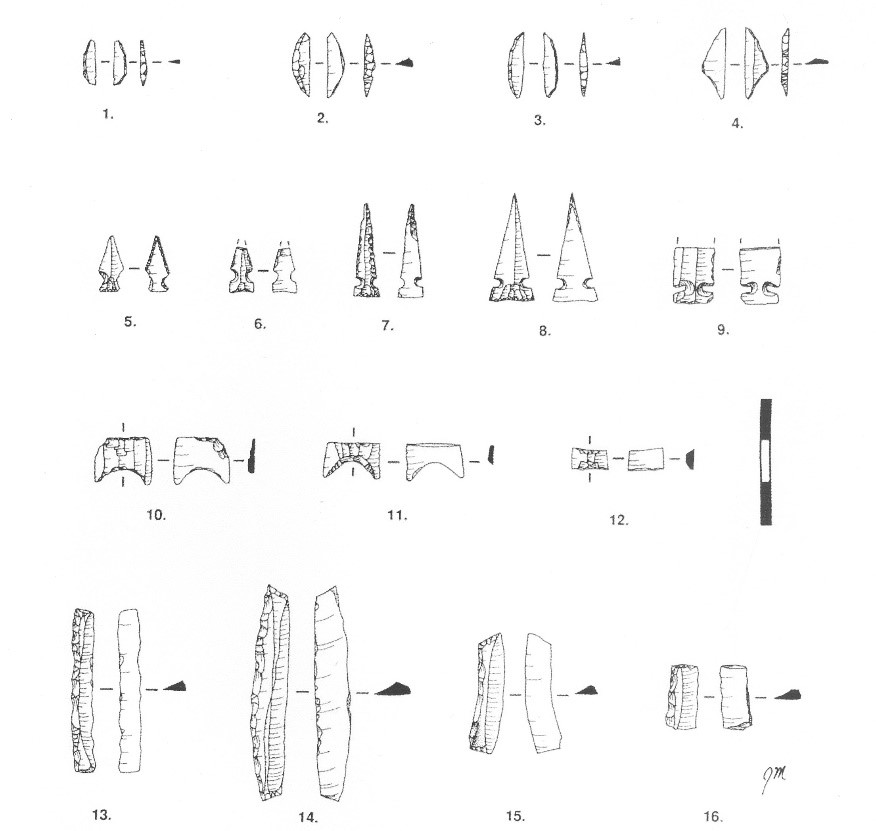السردية التاريخية لمحافظة عجلون :
تمدنا الدراسات الأثرية الميدانية، والنصوص التاريخية الأصلية بالمصادر الرئيسة لهذه السردية، وتدعمها تقارير الرحالة الذين زاروا المنطقة عبر العصور، وقد توصلت الدراسات الأثرية إلى أن المنطقة كانت مسكونة قبل حوالي أربعين ألف عام.
واعتمادًا على الأدوات الصوانية في التشكيلات الجيولوجية وجد أن أقدم أثر للإنسان فوق أراضي الأردن كان في حوض نهر الزرقاء (دوقرة والسخنة) ، وأما في محافظة عجلون فإن أقدمها وجد في منطقة تقع على الحافة الشمالية لأحد الأودية الصغيرة الواقعة بين وادي كفرنجة في الشمال، ووادي راجب في الجنوب، والمعروف باسم "مغر الحمام"، والذي يتكون من خمسة كهوف (مغاور) يصل عمق أكبرها مساحة 12 مترًا، وأقصى ارتفاع لها عشرة أمتار، وعرض مدخلها سبعة أمتار، واستخدامها للاستيطان من المجموعات البشرية قبل أربعين الف سنة .
وقد قامت بعثة أثرية من "جامعة ايموري Emory University" بأمريكا بإجراء تحريات أثرية في المغاور، خرجت نتيجتها بأن هذه الكهوف آوت إليها قبل نحو ح أربعين ألف إلى عشرين ألف سنة جماعات متنقلة تعتمد على الصيد والجمع، وعثروا بين البقايا الأثرية على أدوات صوانية، وعظام حيوانات برية ومنها عظام الغزلان البرية التي كانت تعيش في المنطقة، وعظام بعض حيوانات الماشية والطيور والأسماك.
أما خلال مرحلة انتقال الجماعات البشرية من الصيد والجمع والتجوال إلى الاستقرار وإنتاج الطعام في المنطقة فتعود إلى أكثر من عشرة آلاف سنة، حيث بدأت هذه الجماعات في الزراعة وتدجين الحيوانات، وقد عثر في محافظة عجلون على بوادر أولى لهذه المرحلة، ويظهر أن مجموعة بشرية استقرت داخل كهف كبير مطل على وادي الريان (اليابس) اسمه "عراق الدب" ، وهو كهف يصعب الوصول إلى بابه إلا بتثبيت أزاميل في الصخر.
وقد عثر المنقبون داخل الكهف على أكواخ مبنية أساساتها من الحجارة الغفل(*)، بنيت على شكل شبه دائري، وأما أرضياتها الطينية فمغطاة بطبقة من اللياسة الجصية، وفيها حفر بيضاوية الشكل لتثبيت دعامات لرفع سقف الكوخ، كما عثر على قبرين مع مجموعة من الأدوات الصوانية تمتاز بصغر حجمها وتنسب للثقافة الناطوفية (حوالي 12 الف إلى 15 الف و 500 سنة من الحاضر، كما عثر على عدد من رؤوس السهام الصوانية المؤرخة للعصر الحجري الحديث ما قبل الفخار (حوالي 8 آلاف و500 - 7 آلاف و500 ق . م . )، ووجد أن الأشخاص الذين تم دفنهم داخل هذه الكهوف كانوا مدفونين بوضع القرفصاء داخل القبر، وقد حلل المنقبون مجموعة العينات بواسطة الكربون المشع.
(*) غير المشذبة

بقايا كوخ في عراق الدب

مجموعة من الأدوات الصوانية التي وجدت داخل الكهف
وبالإضافة لموقع "عراق الدب" تم العثور في موقع "تل الراهب" الواقع غرب بلدة عرجان، على عدد من الأدوات الصوانية خاصة رؤوس السهام، وكسر من أدوات بركانية شفافة مصنوعة من خامات السبج(*) التي تتوافر خاماته حاليًا في تركيا ، ويفهم من العثور على مثل هذه المواقع في محافظة عجلون أنها شهدت بوادر الاستقرار والزراعة في الألف التاسع قبل الميلاد ، كحال العديد من مناطق بلاد الشام .
(*) حجر بركاني يأتي من الحمم السوداء
:The Historical Narrative of Ajloun
The main sources for Ajloun’s narrative and history are provided by Archaeological field studies, original historical texts, and supported by accounts of travelers who have visited the region through the ages. Archaeological research have concluded that this area has been inhabited for nearly 40.000 years. The oldest traces of human presence on Jordanian soil, identified through flint tools found in geological formations, were first found in the Zarqa River Basin (in areas like Duwaqarah and As-Sukhnah). In Ajloun specifically, the earliest traces were located on the northern edge of a small valley nestled between Kufranjah valley to the north and Rajeb valley to the south, in an area known as "Maghr al-Hamam." This site comprises five caves, the largest of which extends 12 meters deep, with a maximum height of 10 meters and an entrance width of 7 meters. These caves served as habitable zones for human groups who settled there nearly 40.000 years ago.
An archaeological expedition from Emory University in the United States conducted a detailed investigation of these caves, revealing that these caves indeed housed migratory groups who relied on hunting and gathering between 40.000 and 20.000 years ago. Among the archaeological remains, they discovered flint/stone tools and the bones of wild animals, including wild gazelles that once inhabited and roamed the region, along with remains of some livestock, like birds, and fish.
As humanity transitioned from a nomadic life of hunting and gathering to a more settled lifestyle centered on food production, the region saw its earliest indications of agriculture and livestock domestication by these human groups over 10.000 years ago. The first signs of this stage were evident in Ajloun; as it appears by discoveries that a human group settled inside a large cave called Iraq Ed-Dubb (Or the cave of the bear) overlooking Al-Rayyan valley. Furthermore, accessing this cave is challenging and requires the installation of chisels into the rock to reach its entrance .
Excavators discovered huts within the caves, with foundations of unhewn/unknapped stones arranged in semicircular shapes. The clay floors of these huts were coated with a layer of stucco plaster, and oval shaped holes were found in them to install supports to raise the hut roofs. Additionally, two graves were discovered along with a collection of flint tools characterized by their small size attributed to the Natufian culture, dating back approximately 12,000 to 15,500 years ago. Flint arrowheads from the Pre-Pottery Neolithic period (circa 8,500 – 7,500 BCE) were also found. It was observed that burials of individuals within these caves were interred in a distinctive crouching position. The excavators analyzed samples taken from the site using radiocarbon dating.

Hut remains inside Iraq ed-Dubb (the cave of the bear)

A collection of flint tools found within the cave
In addition to the site of Iraq al-Dubb, further excavations at the site of "Tell al-Rahib," situated west of the town of Arjan, revealed a variety of flint tools, especially arrowheads. In addition, fragments of transparent volcanic tools crafted from obsidian* material (currently found in Turkey) were discovered. The discovery of such sites in the governorate of Ajloun suggests the region's early shift towards stability and agriculture as early as the ninth millennium BCE, paralleling the developments seen across the Levant.
(*) Obsidian: a volcanic stone derived from black lava
:Récit Historique du Gouvernorat d'Ajlun
Les études archéologiques sur le terrain et les textes historiques originaux nous fournissent les principales sources de ce récit et sont étayés par les rapports des voyageurs qui ont visité la région à travers les âges. Des études archéologiques ont montré que la région était habitée il y a environ quarante mille ans.
En se basant sur des outils en silex dans des formations géologiques, il a été constaté que les traces humaines les plus anciennes sur les terres jordaniennes se trouvaient dans le bassin de la rivière Zarqa (Dougra et Sukhna). Quant au gouvernorat d’Ajlun, les plus anciens d’entre eux ont été retrouvés dans une zone située à la limite nord d’une des petites vallées situées entre Wadi Kufranjah au nord et Wadi Rajab au sud, connue sous le nom de « Mughar Al-Hamam », qui se compose de cinq grottes (Cavees), dont la plus grande atteint une profondeur de 12 mètres, sa hauteur maximale est de dix mètres et la largeur de son entrée est de sept mètres. Elle a été utilisée il y a quarante mille ans par des groupes humains.
Une mission archéologique de l'Université Emory aux États-Unis a mené des investigations archéologiques dans les grottes. Le résultat était que ces grottes étaient abritées il y a environ quarante mille à vingt mille ans par des groupes mobiles qui dépendaient de la chasse et de la cueillette. Parmi les vestiges archéologiques, ils ont trouvé des outils en silex, des os d'animaux sauvages, notamment des os de cerfs sauvages qui vivaient dans la région, ainsi que des os de bétail, d'oiseaux et de poissons.
Quant à la transition des groupes humains de la chasse, de la cueillette et de l'errance à l'installation et à la production alimentaire dans la région, elle remonte à plus de dix mille ans. Ces groupes ont commencé à cultiver et domestiquer des animaux, et les premiers signes de cette étape ont été trouvés dans le gouvernorat d'Ajlun. Il semble qu'un groupe de personnes se soit installé à l'intérieur d'une grande grotte surplombant Wadi Al-Rayyan (la terre ferme), appelée « Iraq Al-Dabb». Il s'agit d'une grotte dont la porte est difficile à atteindre sauf en installant des ciseaux dans la roche.
À l'intérieur de la grotte, les fouilleurs ont trouvé des cabanes construites avec des fondations en pierres brutes (*), construites en forme semi-circulaire, et leurs sols en argile étaient recouverts d'une couche de plâtre, et elles contenaient des trous de forme ovale pour installer des supports pour élever le toit de la cabane.
Deux tombes ont également été trouvées avec un groupe d'outils en silex caractérisés par leur petite taille et attribués à la culture natoufienne (il y a environ 12 000 à 15 500 ans à partir d'aujourd'hui). Un certain nombre de pointes de flèches en silex datant du pré ont également été trouvées. -poterie époque néolithique (il y a environ 8 mille 500 - 7 mille 500 avant JC). Il a été constaté que les personnes enterrées à l’intérieur de ces grottes étaient accroupies à l’intérieur de la tombe et les fouilleurs ont analysé le groupe d’échantillons au radiocarbone.

Vestiges d'une cabane en Iraq Al-Dabb

(*) Non élaguée
Une collection d'outils en silex trouvés à l'intérieur de la grotte
Outre le site « Iraq Al-Dabb», de nombreux outils en silex, notamment des pointes de flèches, et des fragments d'outils volcaniques transparents en matières premières d'obsidienne (*), dont les matières premières sont actuellement disponibles en Turquie, ont été découverts à le site «Tal Al-Rahib», situé à l'ouest de la ville d'Arjan. Il ressort de la découverte de tels sites dans le gouvernorat d'Ajlun qu'ils ont connu des signes de stabilité et d'agriculture au IXe millénaire avant JC, comme de nombreuses régions du Levant.
(*) Une pierre volcanique issue de la lave noire